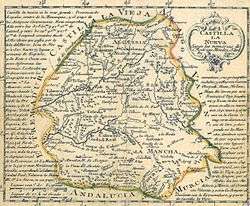New Castile (Spain)


New Castile (Spanish: Castilla la Nueva [kasˈtiʎa la ˈnweβa]) is a historic region of Spain. It roughly corresponds to the southern part of the Castile, taken during the Reconquista of the peninsula by Christian kings from Muslim rulers. Some notable achievements in this reconquest were the capture of Toledo in 1085, ending the Taifa's Kingdom of Toledo, and the battle of Las Navas de Tolosa in 1212. It continued to be called the Kingdom of Toledo when it was in the Crown of Castile. Then, it started to be called New Castile in the 18th century.
New Castile is separated from Old Castile to the north by the Sistema Central range of mountains, and have historically comprised the Spanish provinces of Ciudad Real, Cuenca, Guadalajara, Madrid and Toledo. In more modern administration, it covers the autonomous communities of Madrid and Castile–La Mancha (which also includes Albacete).
See also
- Castile (historical region)
- Old Castile
- Castile–La Mancha
- Kingdom of Toledo
- Nueva Castilla in the Spanish East Indies
- Nueva Castilla in Spanish America
External links
- Jerónimo López-Salazar Pérez, La Historia Rural en Castilla la Nueva y Extremadura, Ed. Univ. de Salamanca
- Castilla la Nueva; (1885), by Quadrado, José María, 1819–1896; Fuente, Vicente de la, 1817–1889,
Coordinates: 39°48′N 3°03′W / 39.800°N 3.050°W